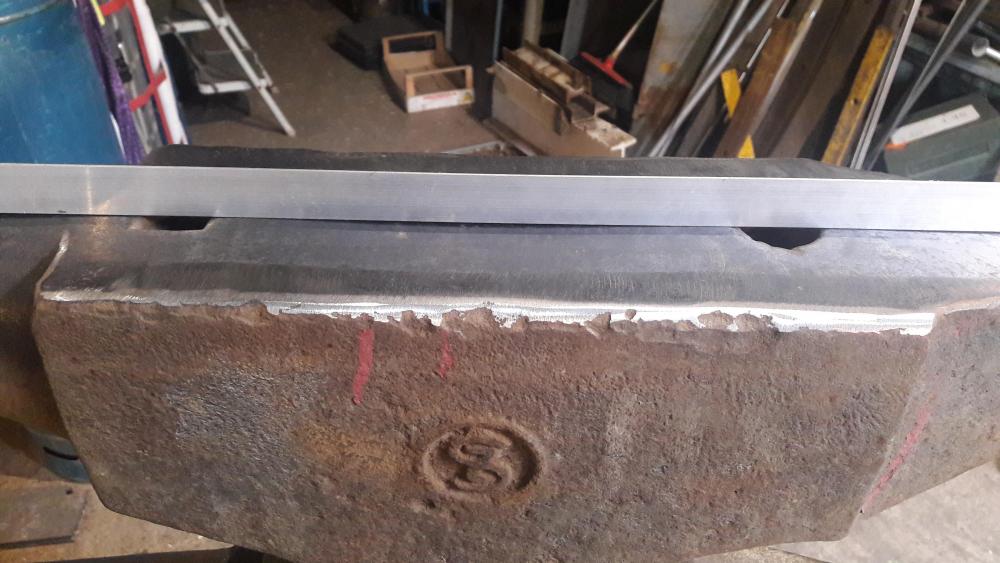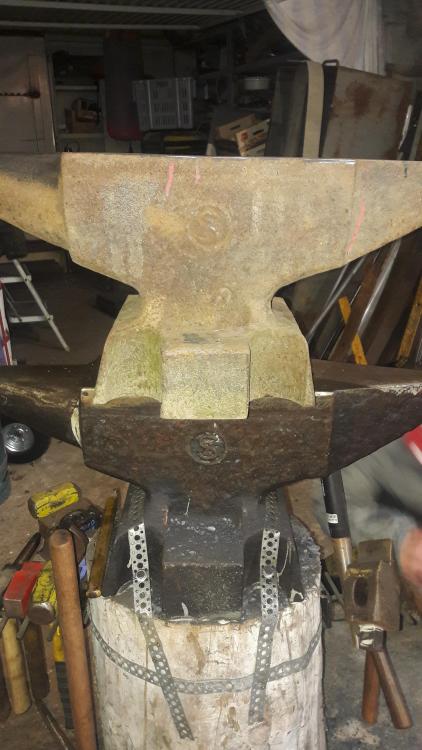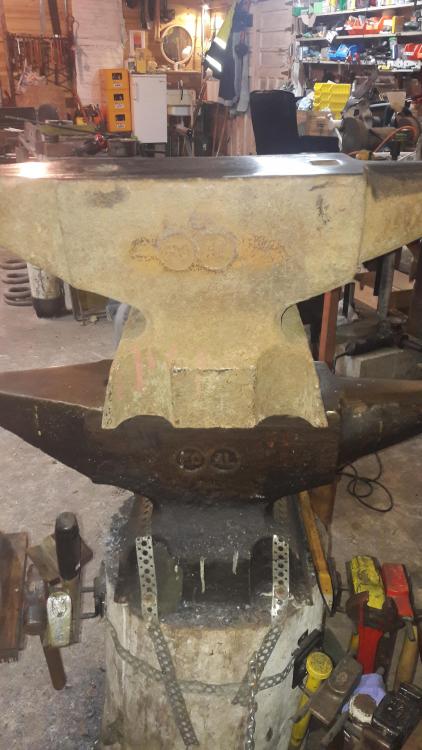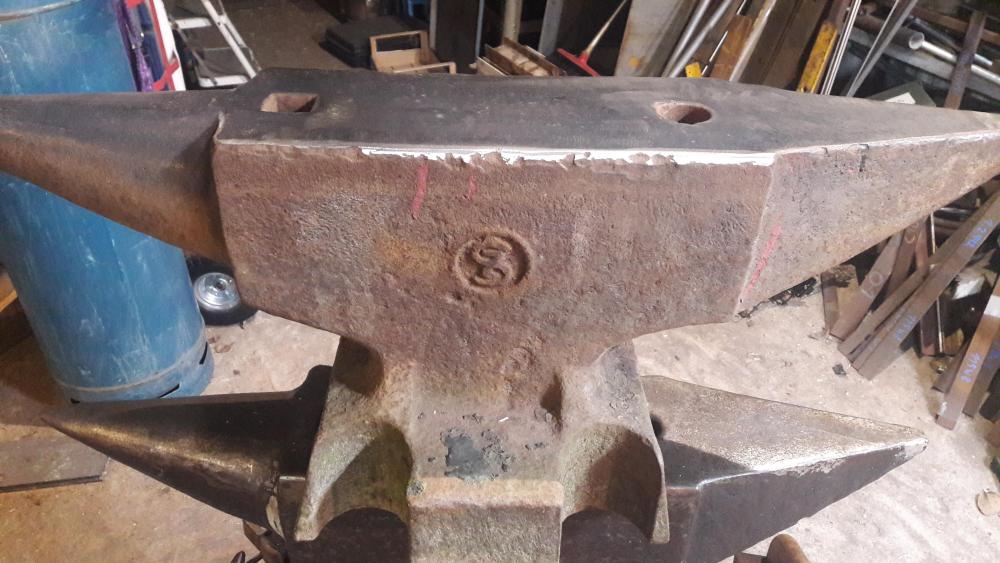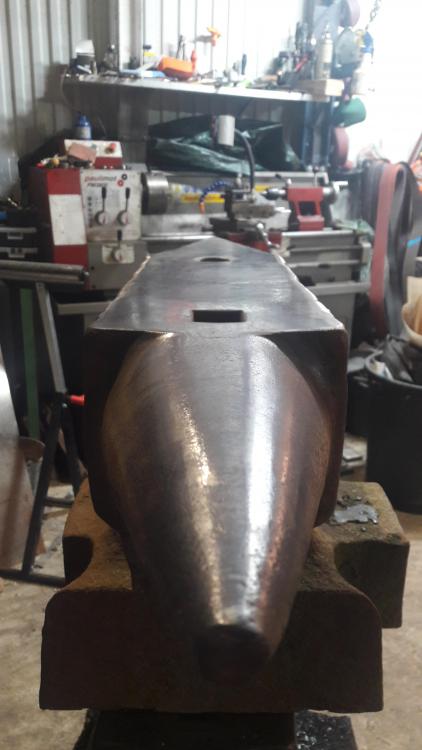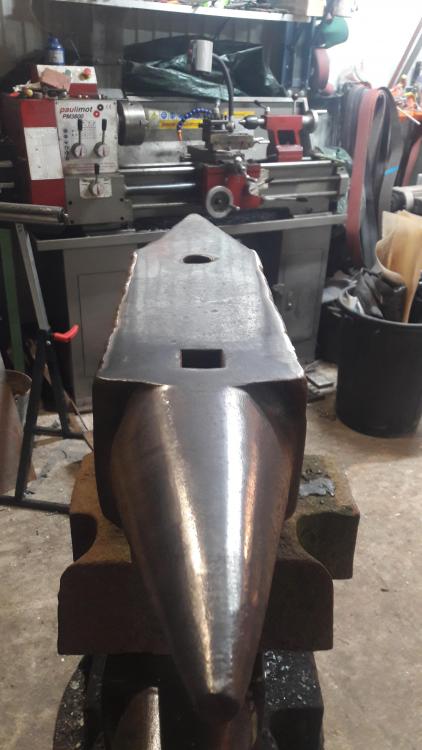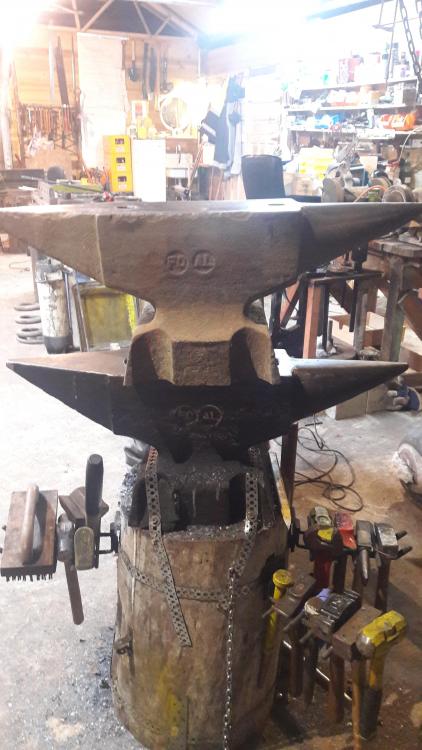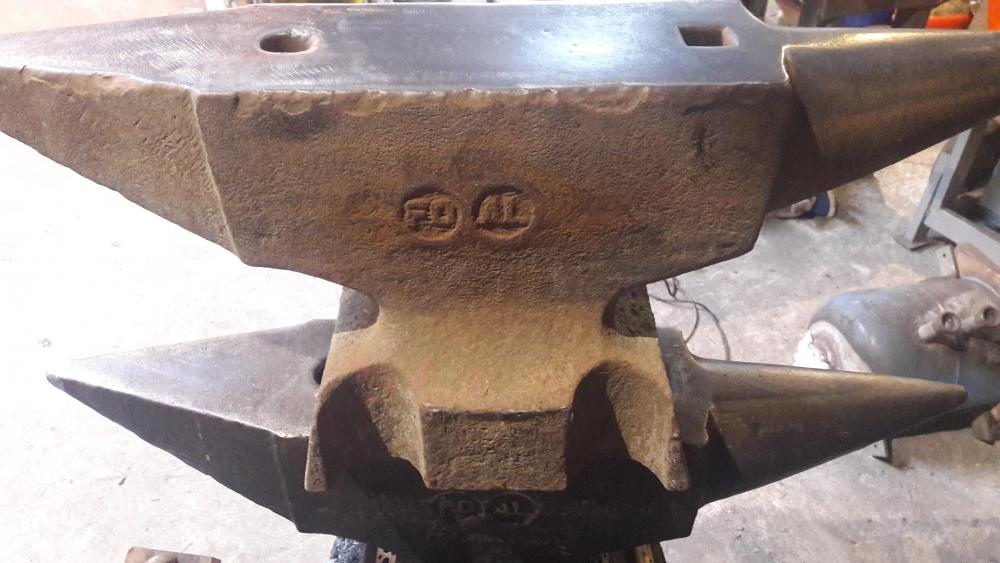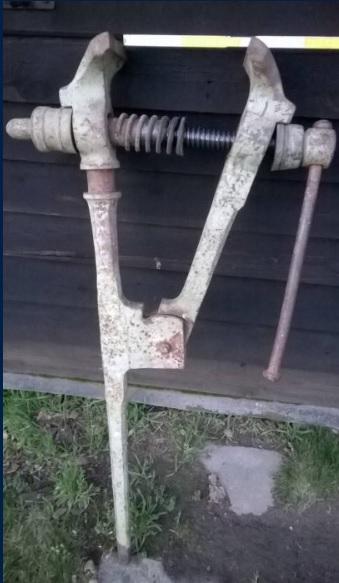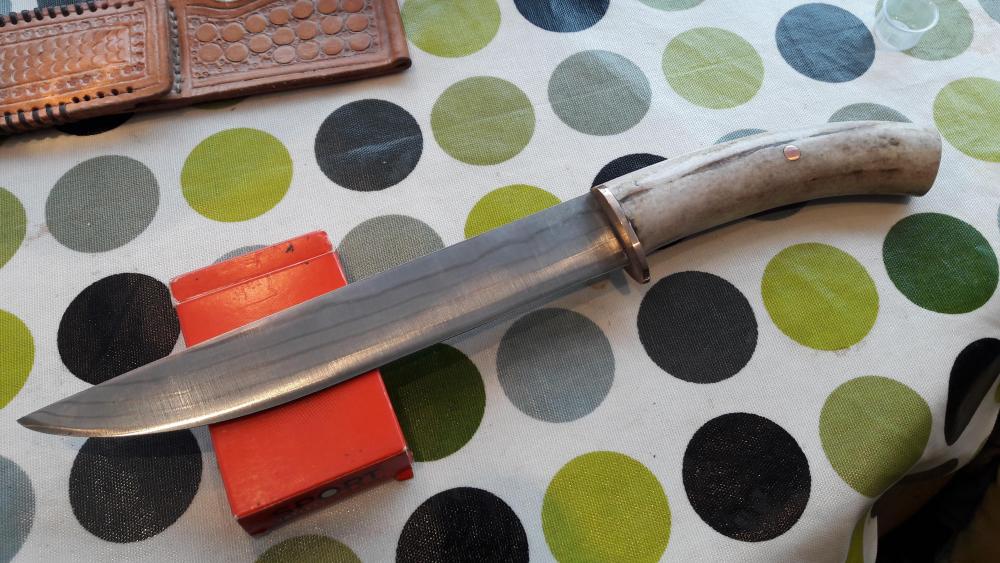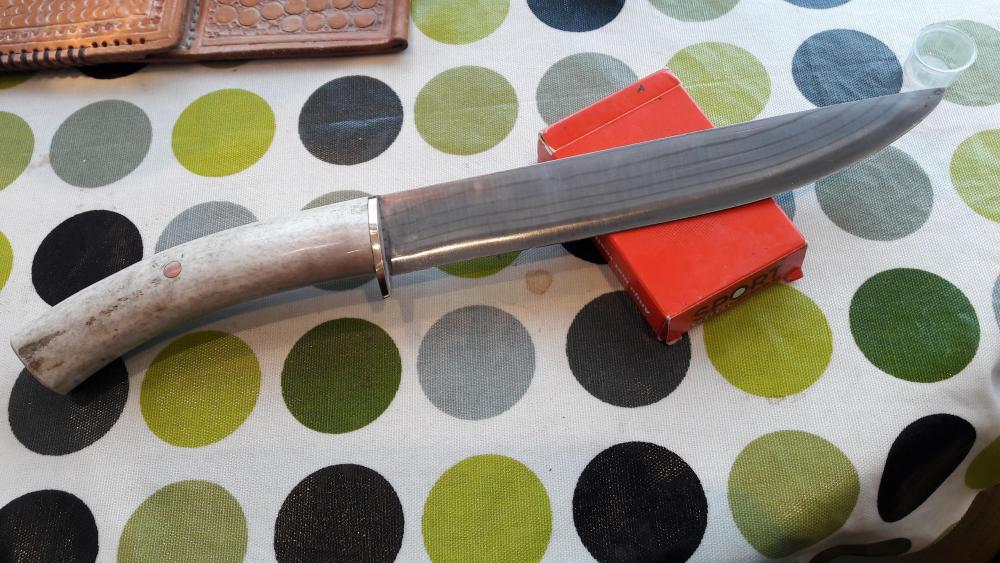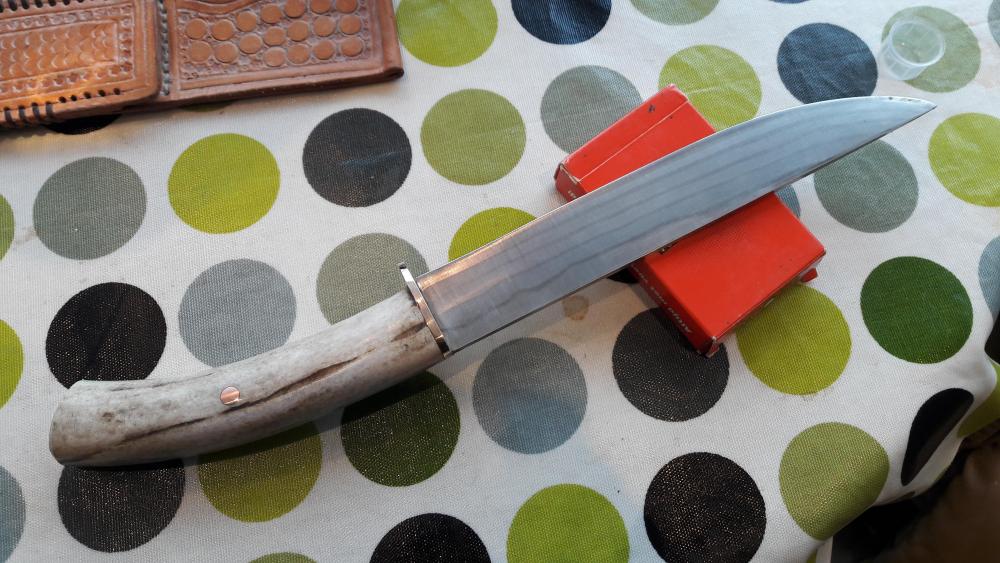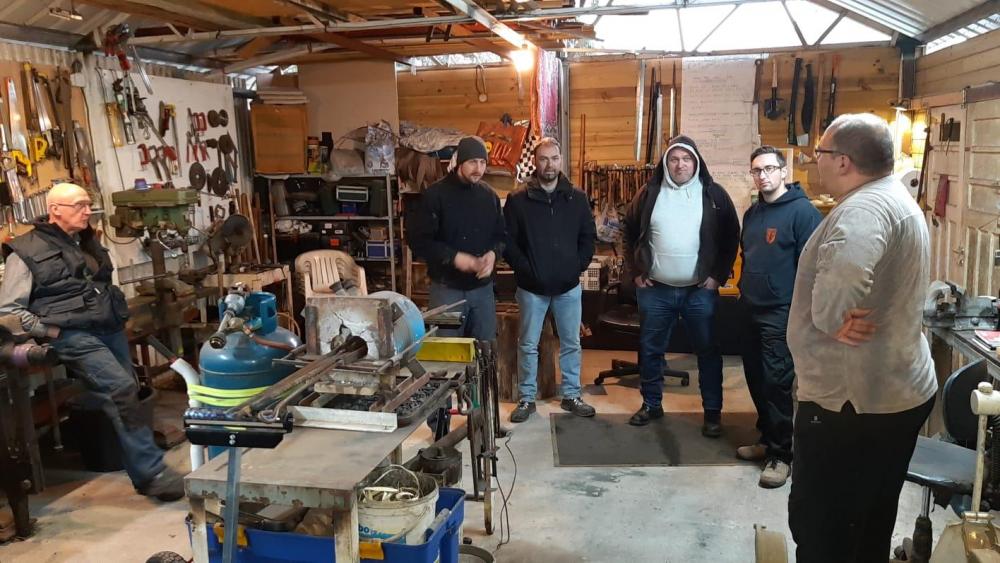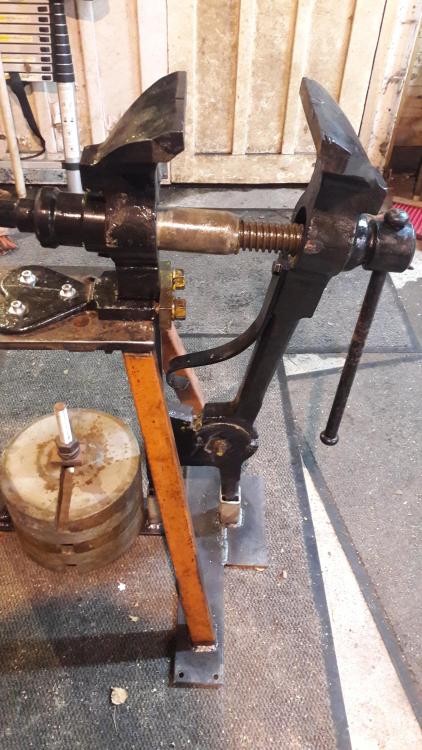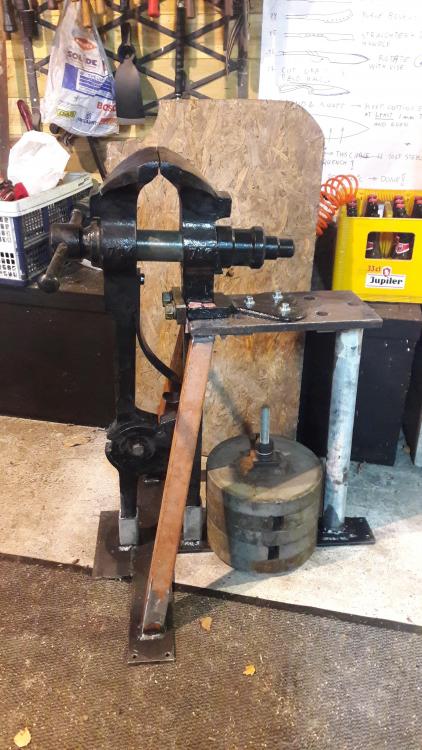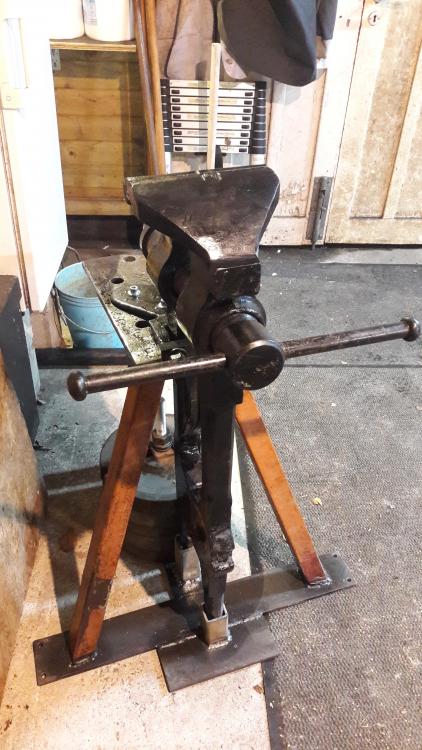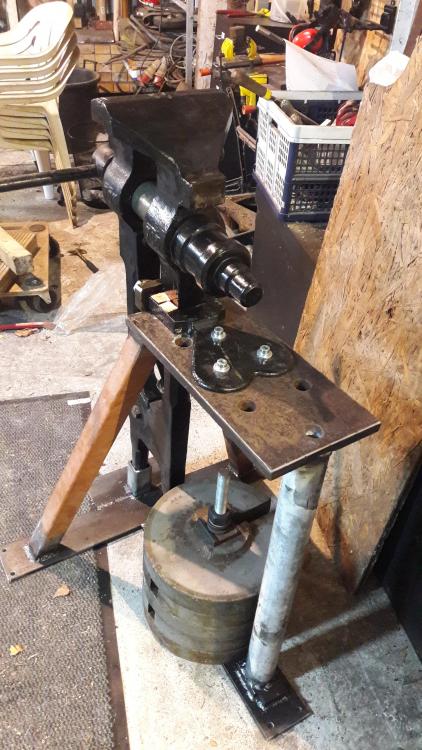
BartW
Members-
Posts
281 -
Joined
-
Last visited
Content Type
Profiles
Forums
Articles
Gallery
Downloads
Events
Everything posted by BartW
-
Well: I'll be honest, I didn't see this one coming either; and I already considered myself lucky in the anvils department. If any of you guys come to belgium, we can hammer some stuff together, so you can try it yourself. From what the guy at skoda foundry works told me they were cast from battle-ship-gun-barrel-steel. All I can tell you is they move steel better than a 250 kilo steel faced anvil. They do have big holes (the square is 30 x 30 mm, the round is 25 mm) and no pritchel hole. Now I do have a question however, but how much would they be worth these days? I know the new Refflinghaus go for about 2000 $, and I've yet to see a second hand Refflinghaus. just FYI, I'm not planning on selling either.
-
Hello all, The history of the older brother : Skoda anvil Anotger railway worker contacted me, told me he had something that I might be interested in, and he would trade it for a case of beer. So I went and came back with this anvil : It's an exact copy of my Skoda, also 115 kilo, solid tool steel, file hard top, going to hrc 50-55 ish in the foot. Finest I've struck, moves metal better than a 250 kilo anvil with a surface hard plate. Hardly any wear (dished about 2 mm), minor edge chips. I gave the dude two cases of beer and a knife to show my appreciation. My weekend is good, and I got pain in the back for lifting this in the car. Mvg Bart
-
Cool. Excellent example of good forging. Proof that even the fanciest anvil and hammer don't make you a good Blacksmith, a lesson for the younger generation. Only practice, learning (from mistakes) and a bit of talent and stubborn - ness will make you a good or bad Blacksmith or bladesmith. Mvg Bart
-
For a stand, less pieces is usually better. If you had access to a tree stump segment, that would be better. Also; cut the burned ends of the rail off; and mount it vertically. You really don't need more surface than the size of your hammer; but you want it to be fixed as solid as possible. I got myself a rail too; then mounted it vertically to a block of wood; then welded 2 pieces of metal to each size of the rail (those welding plates they use to attach one rail to the other ), and ground the surface flat, welded hardfacing rod, ground again and so on ... used that for about 2 years until I had access to much better anvils. Seriously, the white boards will shatter and make the whole unstable after a while; and the long pieces sticking out on the sides cannot be used either.
-
I have more confidence in my post vises than in my machinist vices, but to me the answer to your question on how to prevent it from walking is just add more weight. In my case that would mean add a couple of steel 60 pound disks Also; I'm not sure yet if I prefer twisting horizontally or vertically ... Jury is still out on that one.
-
Hello; Just found this one. Very strange setup - couple parts missing - ; but the spring is quite intresting. Why hasn't anyone ever done this ? Seems like a viable alternative to a leaf spring.I got to try this kind one one of mine too some day :-) greetz; Bart
-
I've played with a couple of firmingy pigs, general round 450 pounds. The hardie hole is "strange"; it usually isn't all the way through; but there is another hardie hole 90 degrees on it; horizontal from the side.This serves to hammer a wedge in to eject the hardie hole from the top. Or the other way around; so you could have an anvil with a horizontal hardy hole. Not all have this "feature" though, I've found some with the hardie hole on the other side, all the way through. Those with a 2-part hardie system should come with the wegde chisel... it's specific to each anvil. They are IMHO uglier than a square plain block. They aren't called "pigs" for nothing That being said, I've tested 6, they all had a straight face; 4 had a thick faceplate - 30 mm or more. 2 were one piece cast steel (these are also newer). my hardness files said between 50 and 60 HRC. They are good anvils; and the sloping arc gives you plenty of options for hammering. For some reason they also makes less noise than a standard german or london pattern anvil. So; if you can get them - go for it. They are good anvils. Good steel too; made by Bonpertus in the days; with good pure carbon steel for the face; and these guys kept the best steel for these anvils. They were expensive; even in france, even back in the day. mvg; bart
-
European anvils being shipped in bulk to the USA ?
BartW replied to BartW's topic in Anvils, Swage Blocks, and Mandrels
Ah we 're all getting along in life. Perhaps not in the direction or at the speed we would like, but we are going anyway. If you are in this business long enough, an anvil is just another tool. A decade ago an old German bladesmith gave me a 300 pound square block of D2 (1.2379) hardened completely. A file skates over it everywhere. I've been comparing any anvil to it, and most I checked sucked. After I registered to this forum and read a lot, I realized I've been spoiled. But every body who wants to get started in blacksmithing or bladesmithing in these parts is royally xxxxxxx. Especially if all the good ones go across the big water. Mvg Bart -
Hello All; When looking at the second hand sites in Belgium-Netherlands- Germany - France; I noticed there are a lot of anvils, but all are verrrry old and more important, if you want a harder face; all you'll find are vulcans. Most don't even have a makers mark. This seems strange, as a couple of great makers of anvils are in this region (Refflinghaus, UAT ...) that make a LOT of anvils. Given the average lifespan of an anvil, and the amount of companies that could use them (and their lifespan), why don't we find truckloads of refflinghaus, UAT, PFP, picard ... anvils in this region ? Then I met a second hand sales guy (retired metal worker), who told me he sold about 600 anvils a year; every time he gets a cast steel or high quality, it gets bought by a swiss metal dealer, who collects them by the truckload and pays 4€/kilo (2 $ / pound). This is very strange, so I did some investigating, and indeed, most "named" anvils also from other guys gets bought by a swiss metal dealer, who sells / ships thousands of them every year to the USA (or so they told me). Really hard to track; so I asked and asked and aksed in the port of Antwerp if they had seen containers full of anvils. This costed me a crate of beer Yesterday, one guys showed me a pic of a container manifest which he said was full of random sized used anvils with letters on them. Bingo. What they do in the USA I have no clue, but the relative absence on the market of (for example) UAT anvils in the USA tells me they are not sold to blacksmiths. The Swiss guy doesn't answer any mails; but the shipping crates go to new york, to a company called Simms (or something like that - can't really read it ). Now question ... are you USA guys shipping our european anvils over there to melt into other things? Is 2$ / pound expensive or cheap for good steel ? Or do you guys have a couple of collectors that have a couple thousand of anvils ? Greetings, bart
-
3M cubitron 2 cutting disks; flap disks and fibre disks. flex-o-vit, Tyrolit & Norton aren't bad either, but 3M beats them for working hard steel. As for machines; I've got 2 Metabo WQ1450 grinders, using 125mm disks (the standard small ones), also got a bosch and a einhell. One makita and one metabo 8inch 230 mm disk grinder. I'll tell you from having held both in my hands cutting - grinding for countless days ... the metabo's are a lot better and safer. I love the safety clutch and the fact they produce less vibration. Haven't touched the bosch or einhell in a solid year, and the 8 inch makita once last week when I was to lazy to swap the disk . the makita is close behind the metabo's tough.
-
Hello All; Back to the question at hand, I kept mine from moving at all. And if I want it to be even heavier, I can add more weight. check the last pics in this thread : https://www.iforgeiron.com/topic/60779-two-leg-vise/ The goal of this setup is to have it outside in the summer (less dust inside) and inside in the winter (too moist & cold). Works well for twisting and even heavy hammering.
-
What can you make from huge drills & reamers ?
BartW replied to BartW's topic in Blacksmithing, General Discussion
Well I don't particularly mind overseas trades. Anyone intrested ? -
A novel approach to flat bar slitting and drifting
BartW replied to bebeaux's topic in Slitters, Punches, Drifts, etc
Well I used 2 trampoline springs and two steel wires around each post just below the box and screw. So I'd have a spring on each side pulling the jaws shut. I need to be able to remove it easily whithout unscrewing the whole vise to use the vise "normally" again. Still; bebeaux's idea seems better. Mount a hardy hole under it; and replace the one spring with 2 springs; and it's a good solution. -
A novel approach to flat bar slitting and drifting
BartW replied to bebeaux's topic in Slitters, Punches, Drifts, etc
That is cool... I was wondering to modify a leg vise in a manner so the jaws would pinch shut with a spring; so I could use it to hammer a drift down without needing to adjust the opening. But this method is way more simple, and seems more efficient. I'm going to try it at some point ... -
Well; I'm not a metalurgist, I was just telling was I was told... I honestly don't know the background; but you did provide a really nice paper which i'm defenitely going to read. Thanks Sly.
-
Well; all (knife) steels have this window after quench, in some it's just so short you can't use it. check the picture in this blogpost, which is marked ttt diagram for 1050 steel : steel TTT diagram . Read the time below on the X-axis. given that we're talking about knives; let's assume 10 to 15 seconds to cooldown in the quenchant. You're basically drawing a straight line from top left to the x-axis where it says 10. Your straight line barely doesn't touch the pearlite/ bainite formation nose. Now untill you reach the horizontal line; your steel is still "malleable"; as if it was copper or pure iron. You can straighten a knife for example in this window with a wooden mallet on a flat piece of wood for example. This is also why if you aircool 1050 steel; it'll remain soft Any standard steels have room under that "nose", and if you remove the knife from your quench tank at say 450 °C; you have a couple of seconds to straighten knives; which will oddly enough keep this form and snap like glass 10 seconds later (once under the martensite formation line). I have a piece of L6 which I use to demonstrate this; heat to non-magnetic; soak a bit; quench in oil; a second after it loses red colour; take it out (it will burst into flames again when use organic oil); blow those out; bend it 30 degrees in a vise; back in the quenchant. a minute later; and cool; try to straighten the 30 degree bend, and it will shatter. I only show this to advanced bladesmiths; as there really is no time to do or think about anything else (or I'm too slow; also possible ). So; the "myth" that you can quench a steel; and straighten it very fast after; then back in the quench tank is scientifically correct . In fact I think you see Ilyia do this several times in the men at armes reforged series. However ... I've *never* been able to straighten a knife perfectly. The only perfectly straight knives I've had came out the quench straight or were ground perfectly straight.
-
Hello all, New knife as a laminating experiment. Center layer (W2 steel) isn't in the center after grinding, hence the difference in sides. But, it's ground full flat to zero, with a hrc 61 center layer. It even has a 30 degrees secondary edge (see the pics). It's extremely sharp. 6 mm spine. Specs : laminate W2 with 7 layers 15n2 \ c75. Bronze pin, bronze guard. 8 inch blade. It's larger than it seems. I love the lines. Very comfy handle too. Time for pics. What do you think?
-
The box looks a lot like a french type.. french rail road works vise . this thread also show some cleaning and painting; but also a stand to make it freestanding... verrry handy. In the picture in this thread; the right black legvise is also a french vise; seems the same construction just heavier. Most french vises (found around here) were made in longwy or lorraine region (maybe that's the "L"), but I know there is also a steel producing area around montpellier... any foundry with casting forging abilities can make these vises. Well; living in Barcelona it should be fairly dry depending how far of the coast you live. However; don't underestimate it; if you build your shop with a lot of metal under trees; it will get wet (like my shop). Hence I paint everything. Legvises for example, I clean with a angle grinder wire brush; then use cleaner (to de-grease) or sandblast if I really need to paint to stick to it; then paint hammerite. I've learned over the years to paint thin several times; instead of painting a thick layer once. There are better paints then say hammerite; for example; the two-part epoxy paint they paint steel diving bottles with ...
-
what to do with a cupped anvil
BartW replied to ADHD-forge's topic in Anvils, Swage Blocks, and Mandrels
One of the big downside of working on solid tool steel anvils is indeed the ring. I wear earplugs all the time; every time I go near a computer room or a datacenter I utterly empty those dispensers; and keep a couple large jars in my workshop A friend of mine had a peddinghaus anvil; and he just couldn't use it anymore because of the sound - granted this was a extremely loud anvil. Back on track about this thread; I'd use it the way it is. Buy a straight anvil for your works requiring a straight surface. You're from Antwerp in belgium right ? Did you know they are still occasionally manufacturing anvils in Turnhout? And that most anvils made there - search for UAT anvils - are shipped to the USA for some reason I have yet to find out. There are plenty of anvils around Belgium; and even a lot more free steel which can serve as anvil. Last week; in Mechelen; they tossed away worn train axles.... 40 of 'm. The external steel recycling firm didn't want them as they were too heavy and too difficult to move. So they stayed in a parking lot for about 5 years untill someone decided to clean them up. I asked the guys to grab a couple for me with a crane; and cut them up in their xxl lathes. So I went home with 4 x 20x60cm axle steel cylinders -
How many anvils do you actually need ?
BartW replied to BartW's topic in Anvils, Swage Blocks, and Mandrels
Yup, I get that question a lot. There is an answer to it too. I don't have a space issue - my workshop is about 6 yards x 12 yards floorspace. With a simple steel roof; in the middle more than 6 yards high. The tips on either side aren't closed; so there's always a light breeze about 2 meters above my head. So no need for smoke evacuation; chimneys... My coalforge is actually mounted in a "hot table"; and that is mobile. I also have a gasforge which is also on wheels. So I can put my forge being used right next to the anvil if I wanted to. My forge is basically the center of a cube / rectangle; with 2 corners being 2 anvils; and the 2 other corners being a workbench with a large post vice on each. I basically move the hot table or gasforge to the side I need it most when I'm doing something specific. It's simpler than moving the anvils which are more then 200 pounds each; with an equally heavy wooden block as foot. However; this setup shines when gives classes ... people don't bump into each other; people don't burn each other with a piece of hot metal ... and you can keep a nice overview of what everyone is doing. mvg; Bart P.S. I attached a picture ... below the lamp behind those two guys is anvil 1; you can see the "hot table" with the gas forge sitting on top of the coal forge. That whole table is on wheels. The other half of my shop - not in this picture - is structured the same way. anvil in the center, also about 3 meters away from this table. The yellow "block" is the anvil-ish tool that stays next to the forge. -
What's the lifetime expectation of an anvil ?
BartW replied to BartW's topic in Anvils, Swage Blocks, and Mandrels
I also got a czech cast steel one born in the 1930'ies; 200 pounds. ( skoda anvil )One day someone was making damascus on it; and he couldn't "brush" the black stuff off that built up on the face. He decided to grab a wood chisel and scrape it off. When I saw that; I wasn't too happy; but upon inspecting the anvil; I told him he had to resharpen the chisel. There is literally not even a scratch on it. I do love the anvil; And I keep it clean and apply oil to it's face several times a week. So I'm inclined to agree with Frosty; however; that begs the question; given our current steel "standard" why aren't all anvils made in solid hi quality steel; and if used correctly for like light use (like I do); it should last basically forever? Then ... who's making the crap anvils? And why ? There are a LOT of crap anvils floating around. -
Hello; First of all; happy new year. This is my first post anywhere in 2019; and I wish you all best wishes for the new year. Second; Today I was making wall hooks to hang stuff - I only had about an hour before we had to do the tour of every family member in the neighbourhood. Then I realized; I hit my anvil with a really way too hard hammer but I couldn't even change the scratch pattern. My hammer deformed and cracked.... Both my anvils are super hard high HRC 60'ies high carbon single block steel. Then i asked myself a question I don't have an answer to. How long do anvils last ? I can imagine someone using something like the vulcan I used to have; that would have left a dent. If you were hammering on it every day; professionally; I can imagine something like a vulcan being swayed in a couple years; and probably not lasting 10 years in a professional forging workshop. But I'm not a professional metal guy. I light my forge 3 to 4 times a week for a couple for hours each time. I make one or two knives a months if somebody wants one. Professionally I work in IT - Linux Unix-Cloudy-storage-licensing expert. Still... how long do anvils last ? I cannot seem to do anything at all to my block of D2 (1.2379) hardened at HRC 66; and my skoda anvil basically has more rust issues than people using sledgehammers on it. I assume my kids (now 5 and 7 years old) can still use them; but even older ? If they are eternal things; why do I see so many swayed and damaged anvils popping up on the local flea market ? Suppose a 200 pound one piece tool steel anvil; hardened as hard as a file; one guy using sledgehammers on it all day for 20 years would leave the surface shiny and the foot rusted; and wear out a lot of sledgehammers; but the anvil doesn't really wear . so in this "golden age" of super steels; what's the life expectation of ahigh quality anvil ? greetz; Bart
-
How many anvils do you actually need ?
BartW replied to BartW's topic in Anvils, Swage Blocks, and Mandrels
I got a block of hardened steel; 15 inch long; 5 x 5 inch square lying next to the forge. Initially I figured; when it gets really cold in my workshop; I'll light the coal forge and use it as stove. Then i figured; the more mass heated up would mean more residual / IR heat; cq when i'm working on my work benches, I have my back towards the coal forge (nice 'n cosy) - which makes sub zero temperatures more bearable. Later I found I was using the block a lot to do small stuff; to save me the 3 steps towards the anvil . It's been lying next to my coal forge ever since; and I had a buddy of mine drill a 2 inch, a 1,5, a 1 and a 0,5 inch hole in it. Verrry handy having a anvil a foot away from the forge. mvg; Bart -
Well; You guys were right. couple of hours welding 'n cutting; and I've made myself a extremely stable stand. For those wodering; the disks of Iron (these are soft plain iron; not cast iron. They are not brittle at all) are about 50 pounds each; so the "counterweight" makes it virtually impossible to make the vise fall over in any direction. Now I got to paint it to cover up my welding ...
-
I agree with that; where there's blacksmiths and borax, fertility is decreased. But I think the factor inbetween is the heavy iron/steel things like leg vise handles hitting you between the legs mvg; Bart
